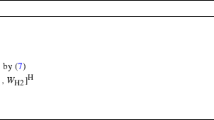Abstract
The Reciprocal Work Contour Integral Method (RWCIM) is a computationally advantageous method of calculating stress intensities and higher order eigenvector coefficients for a general opening crack in a single or bi-material configuration. It involves integrating functions of analytical solutions and finite element results along an inner and outer contour. Except for the case of a zero opening crack in a single material, there can be computational difficulties with the method in calculating higher order eigenvector coefficients. For those cases, predicted lower ordered coefficients are insensitive to higher order eigenvectors only for a small inner contour radius. However, for a small inner contour radius, coefficient prediction with the RWCIM can become very sensitive to the value assumed for that radius. A numerical algorithm is presented for determining if an inner contour radius is adequate to have the algorithm insensitive to both higher order eigenvectors and the value assumed for the inner contour radius. An example is presented emphasizing salient points.
Similar content being viewed by others
References
M.L. Williams,Journal of Applied Mechanics (1952) 526–528
Ibid, (1957) 109–114
L.Gu and T.Belytschko,International Journal of Solids and Structures 31, No. 6 (1994) 865–889
B. Gross, ‘Some Plane Problem Elastostatic Solutions for Plates Having a V-Notch’, Ph.D. thesis, Case Western Research University (January 1970)
B.Gross and A.Mendelson,International Journal of Fracture Mechanics 8 (1972) 267–276
K.Y.Lin and P.Tong,International Journal for Numerical Methods in Engineering 15 (1980) 1343–1354
W.C.Carpenter,International Journal of Fracture 24 (1984) 255–266
W.C.Carpenter,International Journal of Fracture 27 (1985) 63–74
A. Kobayashi, D. Maiden, B. Simon and S. Iida, ‘Application of the Method of Finite Element Analysis to Two-Dimensional Problems in Fracture Mechanics’, Paper 69 WA-PVP-12, ASME Winter Annual Meeting, November 1969
Y. Yamamoto, inRecent Advances in Matrix Methods of Structural Analysis and Design, University of Alabama Press (1971) 85–103
G.B.Sinclair and D.Mullan,International Journal for Numerical Methods in Engineering 18 (1982) 1587–1600
M. Stern and M. Soni, inComputational Fracture Mechanics, Proceedings 2nd US National Congress on Pressure Vessels and Piping, San Francisco, CA. (1975)
M.Stern, E.B.Becker and R.S.Dunham,International Journal of Fracture 12 (1976) 359–368
M.Stern and M.L.Soni,International Journal of Solids and Structures 12 (1976) 331–337
C.C.Hong and M.Stern,Journal of Elasticity 8 (1978) 21–34
M.Stern,Journal of Elasticity 9 (1979) 91–95
W.C.Carpenter,International Journal of Fracture 24 (1984) 45–58
W.C.Carpenter,International Journal of Fracture 26 (1984) 201–214
G.B.Sinclair, M.Okajima and J.H.Griffin,International Journal for Numerical Methods in Engineering 20 (1984) 999–1008
W.C.Carpenter and C.Byers,International Journal of Fracture 35 (1987) 245–268
W.C.Carpenter and C.Byers,International Journal of Fracture 37 (1988) 107–121
Author information
Authors and Affiliations
Rights and permissions
About this article
Cite this article
Carpenter, W.C. Insensitivity of the reciprocal work contour integral method to higher order eigenvectors. Int J Fract 73, 93–108 (1995). https://doi.org/10.1007/BF00055723
Received:
Accepted:
Issue Date:
DOI: https://doi.org/10.1007/BF00055723




